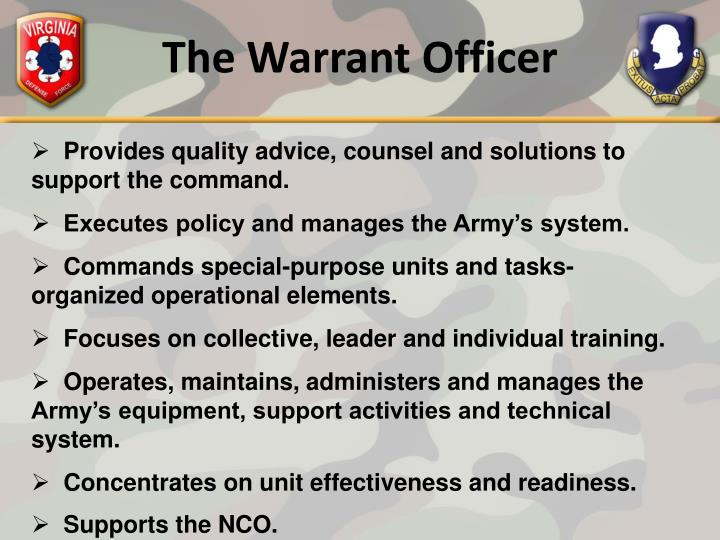

Offer extensive professional experience and technical knowledge.Maintain, administer, and manager the US Army’s equipment, support activities, and technical systems.Provide quality advice, counsel, and solutions to support their unit/organisation.Command aircraft, maritime vessels, and special units.This is in contrast to commissioned officers who have a more general assignment pattern, however, they can lead and direct soldiers the same as other officers (in both leadership and staff roles). Warrant officers are usually functionally orientated, possessing a high degree of specialisation in a particular field. 1.2 Warrant Officers: What They Are and What They Do The aim of this article is to describe the fundamental entry requirements, selection process and training for personnel seeking to become a US Army Warrant Officer. Part Five provides a brief summary followed by some useful publications and links, and finally some references. Part Four outlines the training process for warrant officers. Part Three describes the entry standards and application process. Part Two describes the personnel and organisations that have an impact on warrant recruitment, selection and training. Part One is the background which outlines what warrant officers are and what they do, provides a brief history of warrant officers in the US Army and an outline of the WO 2025 strategy. This article is divided into five parts for easier reading. The US Army requires approximately 1,200 warrant officer candidates each year (Jarrett, 2017). “The Army is looking for candidates to fill some of its 45 different warrant officer specialties, including the new military occupational specialty 923A, Petroleum Systems Technician, authorized for Oct.

Since the 2000s, warrant officers have officially been part of the officer corps of the US Army.Ī warrant officer’s primary task, as a leader, is to serve as a technical expert, providing valuable skills, guidance, and expertise to commanders and organisations in their particular field. For the chief warrant officer ranks (CW2 to CW5), warrant officers are commissioned by the President of the United States and take the same oath as regular commissioned officers. Whilst the various ranks of warrant officer are authorised by the US Congress, each branch of military service (with the exception of the US Navy which stopped appointing warrant officers in 1959) selects, manages, and utilises warrant officers in a slightly different manner.įor appointment to warrant officer one (WO1), a warrant is approved by the secretary of the respective service. The American model differs from the British Army, commonwealth, and other military organisations, where warrant officers are the most senior of the other ranks (OR‑8 and OR‑9) and considered equivalent to the American grades of E‑8 and E‑9 (e.g. cadets and midshipmen), but subordinate to the commissioned officer grade of O‑1 (OF-1) or Second Lieutenant. In the America model of armed forces, the five ranks of warrant officer are classed as officers above the senior enlisted ranks and officer candidates (e.g. This article provides an overview of the selection and training of the United States (US) Army’s Warrant Officers’. “Officers (including warrant officers) hold their grade and office under a commission issued under the authority of the President of the United States or the Secretary of the Army.” (DA, 2012, p.2-1).

Part 01: Introduction to US Army Warrant Officers.


 0 kommentar(er)
0 kommentar(er)
